
Sentrum: The Vibrant Heart of Oslo
Discover Sentrum in Oslo: A thriving district where historic landmarks, cultural treasures, and modern attractions blend seamlessly in Norway's capital city.
Sentrum, the bustling core of Oslo, is where the city's rich history, modern architecture, and vibrant culture converge. As the central district, Sentrum is home to many of Oslo's key attractions, including the Royal Palace, Oslo City Hall, and the Nobel Peace Center. Strolling through Sentrum, you'll be captivated by the mix of historic landmarks and contemporary buildings that tell the story of Oslo's evolution. Karl Johans gate, the main street running through Sentrum, is a lively thoroughfare lined with shops, cafes, and restaurants. Here, you can enjoy everything from high-end fashion to local delicacies. This pedestrian-friendly street culminates at the Royal Palace, where you can witness the daily changing of the guard. Nearby, the Oslo Opera House, with its unique sloping roof, invites visitors to walk on its surface and take in stunning views of the fjord and the city. Sentrum is not just about sights; it's also a hub for cultural experiences. The area boasts numerous museums, galleries, and theaters, offering a deep dive into Norwegian art, history, and performing arts. For those looking to relax, the waterfront promenade at Aker Brygge is perfect for a leisurely walk, dining with a view, or simply soaking in the maritime atmosphere. Sentrum's vibrant nightlife, with its array of bars and clubs, ensures that the district remains lively well into the night.
Local tips in Sentrum
- Visit the Royal Palace at 1:30 PM to see the changing of the guard ceremony.
- Wear comfortable shoes as Sentrum is best explored on foot.
- Head to the rooftop of the Oslo Opera House for panoramic views of the city and fjord.
- Explore the local eateries at Aker Brygge for a taste of Norwegian cuisine with a view.
- Check out the National Gallery to see Edvard Munch's famous painting, 'The Scream'.
Sentrum: The Vibrant Heart of Oslo
Sentrum, the bustling core of Oslo, is where the city's rich history, modern architecture, and vibrant culture converge. As the central district, Sentrum is home to many of Oslo's key attractions, including the Royal Palace, Oslo City Hall, and the Nobel Peace Center. Strolling through Sentrum, you'll be captivated by the mix of historic landmarks and contemporary buildings that tell the story of Oslo's evolution. Karl Johans gate, the main street running through Sentrum, is a lively thoroughfare lined with shops, cafes, and restaurants. Here, you can enjoy everything from high-end fashion to local delicacies. This pedestrian-friendly street culminates at the Royal Palace, where you can witness the daily changing of the guard. Nearby, the Oslo Opera House, with its unique sloping roof, invites visitors to walk on its surface and take in stunning views of the fjord and the city. Sentrum is not just about sights; it's also a hub for cultural experiences. The area boasts numerous museums, galleries, and theaters, offering a deep dive into Norwegian art, history, and performing arts. For those looking to relax, the waterfront promenade at Aker Brygge is perfect for a leisurely walk, dining with a view, or simply soaking in the maritime atmosphere. Sentrum's vibrant nightlife, with its array of bars and clubs, ensures that the district remains lively well into the night.
Iconic landmarks you can’t miss
Oslo Cathedral
Explore the stunning Oslo Cathedral, a beautiful blend of history and architecture located in the heart of Norway's vibrant capital, Oslo.

Slottsplassen
Explore Slottsplassen, Oslo's majestic royal square, where history and beauty converge amidst regal architecture and vibrant gardens.
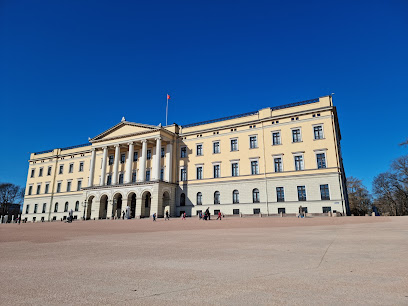
Fountains at City Hall Square
Experience the charm of the Fountains at City Hall Square in Oslo, where stunning water displays meet vibrant urban life.

Karl Johan-monumentet
Discover the Karl Johan Monument in Oslo, a stunning tribute to Norway's rich history and a vibrant symbol of its cultural heritage.

City Hall Square
Explore the historical and cultural heart of Oslo at City Hall Square, a vibrant hub with stunning architecture and beautiful views of the fjord.

Aker Brygge Clock Tower
Discover the charm of Aker Brygge Clock Tower, a stunning landmark showcasing Oslo's rich maritime heritage and vibrant waterfront culture.

Viewpoint Pier Oslo
Experience the breathtaking views and serene ambiance of Viewpoint Pier in Oslo, your gateway to Norway's stunning fjords and maritime adventures.

Statue of Franklin D. Roosevelt
Discover the inspiring Statue of Franklin D. Roosevelt in Oslo, a serene tribute to leadership set amidst beautiful park surroundings.
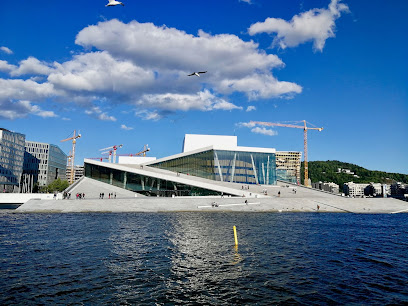
Oslo Regnbuegate
Explore the vibrant Oslo Regnbuegate, a colorful street adorned with stunning murals and artistic expressions in the heart of Norway's capital.
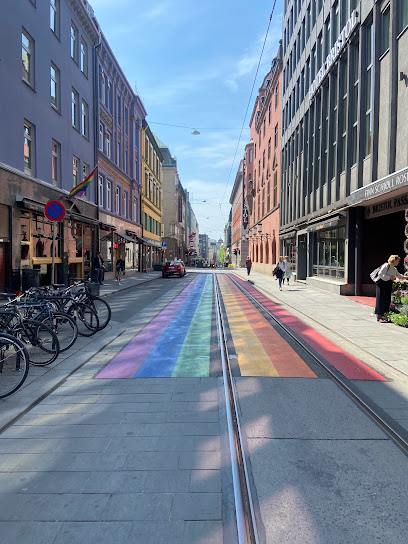
Stortings plass
Discover the historic Stortings Plass in Oslo, a serene memorial park celebrating Norway's democratic heritage amidst vibrant city life.

Unmissable attractions to see
Oslo Cathedral
Discover the beauty and history of Oslo Cathedral, a stunning Baroque masterpiece and a vital part of Norway's rich cultural heritage.

Nobel Peace Center
Discover the transformative power of peace at the Nobel Peace Center in Oslo, where history, art, and humanity converge.

The Oslo Tree
Discover The Oslo Tree, a unique urban oasis combining art and nature at Filipstad Brygge, reflecting Oslo's vibrant culture and stunning landscapes.

Moren (The Mother)
Explore Moren (The Mother), an artistic tribute to motherhood in Oslo, surrounded by vibrant city life and cultural richness.

Oslo Regnbuegate
Experience the vibrant colors and artistic spirit of Oslo Regnbuegate, a must-visit cultural hub in Norway's capital.

Essential places to dine
Den Glade Gris
Discover the heart of Norway's culinary heritage at Den Glade Gris - a traditional restaurant in Oslo offering authentic flavors and warm hospitality.

Prima Fila Restaurant
Discover authentic Italian flavors at Prima Fila Restaurant in Oslo's vibrant Sentrum area - where every meal is a culinary journey.

Elias mat & sånt
Experience authentic Norwegian cuisine at Elias mat & sånt in Oslo - where tradition meets modern dining.

Ruffino
Experience authentic Italian cuisine at Ruffino in Oslo - where tradition meets modern dining in an elegant atmosphere.

Restaurant Fjord
Experience the finest seafood dining at Restaurant Fjord in Oslo - where fresh ingredients meet exceptional culinary artistry.

Maaemo
Discover Maaemo: A Michelin-starred fine dining experience celebrating Norwegian cuisine with local ingredients in Oslo.

Gamle Raadhus Restaurant
Discover authentic Norwegian cuisine in Oslo at Gamle Raadhus Restaurant – where tradition meets taste.

Restaurant EiK
Discover culinary excellence at Restaurant EiK in Oslo - where fine dining meets exquisite flavors and an exceptional wine selection.

Rest
Discover the culinary gem of Oslo at Rest - where innovative dishes meet elegant ambiance for an unforgettable dining experience.

Oslo restaurant Mona lisa Huset
Savor exquisite French and Italian dishes blended with traditional Norwegian cuisine at Oslo's Mona Lisa Huset.

Markets, malls and hidden boutiques
Steen & Strøm Department Store
Experience the elegance of Steen & Strøm, Oslo's historic department store, featuring luxury shopping, gourmet dining, and unique local finds.

EGER
Discover EGER, Oslo's premier shopping mall featuring a blend of luxury, local brands, and exceptional dining experiences in the heart of the city.

UFF Vintage Heaven
Explore UFF Vintage Heaven in Oslo for unique vintage clothing and eclectic finds, perfect for sustainable fashion lovers and treasure hunters.

Alle Tiders Shop - Suvenir og outdoor butikk!
Explore Alle Tiders Shop in Oslo for unique souvenirs, stylish clothing, and outdoor gear that capture the spirit of Norway.

Alle Tiders
Explore Alle Tiders, a unique souvenir store in Oslo offering a wide range of gifts, clothing, and Norwegian culture for every tourist.
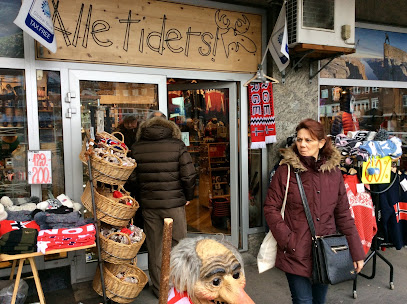
QOMO Oslo
Explore QOMO Oslo, a hidden gem in Grünerløkka, offering unique gifts, stylish clothing, and a cozy lounge experience that reflects Norwegian culture.
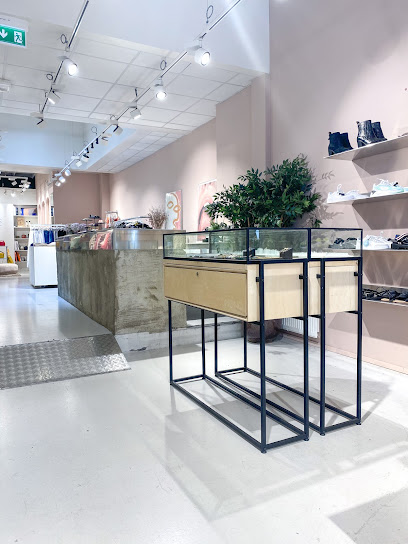
Oslo By shop
Experience the vibrant shopping scene at Oslo By Shop, where luxury meets local charm in the heart of Norway's capital.

Bottega Veneta Oslo Prinsens Gate
Explore the exquisite world of Bottega Veneta in Oslo, where luxury, craftsmanship, and style converge in a stunning boutique experience.

Souveniers
Explore Oslo's vibrant shopping scene with unique souvenirs, traditional crafts, and local delicacies that encapsulate the essence of Norway.
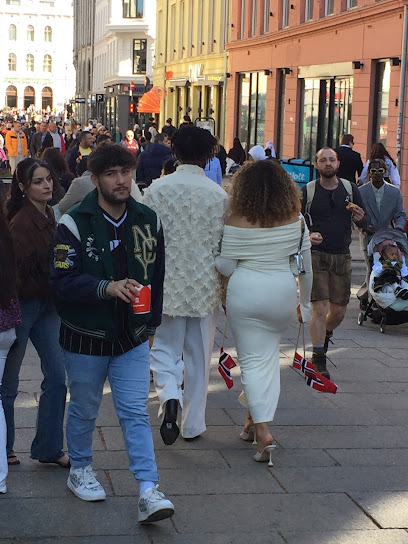
Freyja Shop
Explore Freyja Shop in Oslo, your ultimate destination for unique clothing, jewelry, and souvenirs that embody the spirit of Norway.

Essential bars & hidden hideouts
Scotsman
Experience the vibrant atmosphere of The Scotsman in Oslo - a lively pub offering live music, sports, and delicious food in the heart of the city.

HIMKOK Storgata Destilleri
Discover the artisanal cocktail experience at HIMKOK Storgata Destilleri, where creativity meets local flavors in a vibrant Oslo setting.

Sir Winston's Public House
Discover the lively Sir Winston's Public House in Oslo, where great drinks, live music, and sports come together for an unforgettable experience.

SVANEN Cocktailbar
Discover Oslo's vibrant nightlife at Svanen Cocktailbar, where expertly crafted cocktails and a friendly atmosphere await you. Experience mixology at its finest.

Angst
Discover Oslo's vibrant nightlife at Angst, a bar nestled in the heart of Sentrum, offering signature cocktails and a lively atmosphere.

Summit Bar
Experience the best of Oslo from the heights of Summit Bar, where stunning views and exquisite cocktails await every visitor.

Eight
Discover Oslo's vibrant nightlife at Eight, a stylish bar on Karl Johans gate known for its unique drinks and inviting atmosphere.

Bar *ISM
Experience the vibrant nightlife of Oslo at Bar *ISM, where exquisite cocktails and an elegant atmosphere await.

John's Bar
Discover the lively atmosphere of John's Bar in Oslo, where vibrant nightlife meets a diverse drink selection for an unforgettable experience.

BAR BOMAN
Experience Oslo's vibrant culture at BAR BOMAN, an art café and cocktail bar where creativity meets relaxation in the city's heart.
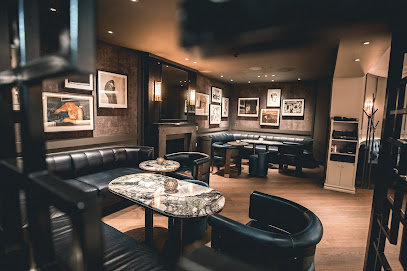
Local Phrases
-
- HelloHei
[hay] - GoodbyeHa det bra
[ha deh bra] - YesJa
[yah] - NoNei
[nay] - Please/You're welcomeVær så god
[vair soh good] - Thank youTakk
[tahk] - Excuse me/SorryUnnskyld
[oon-shuld] - How are you?Hvordan har du det?
[vohr-dahn har doo deh] - Fine. And you?Bra. Og du?
[bra oh doo] - Do you speak English?Snakker du engelsk?
[snahk-er doo eng-elsk] - I don't understandJeg forstår ikke
[yay for-stor eek-eh]
- HelloHei
-
- I'd like to see the menu, pleaseJeg vil gjerne se menyen, takk
[yay veal yair-neh say men-yen, tahk] - I don't eat meatJeg spiser ikke kjøtt
[yay spee-ser ee-keh shøt] - Cheers!Skål!
[skohl] - I would like to pay, pleaseJeg vil gjerne betale, takk
[yay veal yair-neh beh-tah-leh, tahk]
- I'd like to see the menu, pleaseJeg vil gjerne se menyen, takk
-
- Help!Hjelp!
[yelp] - Go away!Gå bort!
[goh bohrt] - Call the Police!Ring politiet!
[ring poh-lee-teet] - Call a doctor!Ring en lege!
[ring en lay-geh] - I'm lostJeg har gått meg vill
[yay har goht may veal] - I'm illJeg er syk
[yay air seek]
- Help!Hjelp!
-
- I'd like to buy...Jeg vil kjøpe...
[yay veal sherp-eh] - I'm just lookingJeg bare ser
[yay bah-reh sair] - How much is it?Hvor mye koster det?
[vor mew-eh kus-ter deh] - That's too expensiveDet er for dyrt
[deh air for deert] - Can you lower the price?Kan du senke prisen?
[kan doo sen-keh pree-sen]
- I'd like to buy...Jeg vil kjøpe...
-
- What time is it?Hva er klokka?
[vah air kloh-kah] - It's one o'clockKlokka er ett
[kloh-kah air eht] - Half past (10)Halv ti
[halv tee] - MorningMorgen
[mohr-gehn] - AfternoonEttermiddag
[eh-ter-mee-duhg] - EveningKveld
[kveld] - YesterdayI går
[ee gor] - TodayI dag
[ee dahg] - TomorrowI morgen
[ee mohr-gehn] - 1En
[en] - 2To
[too] - 3Tre
[tray] - 4Fire
[fee-reh] - 5Fem
[fem] - 6Seks
[seks] - 7Syv
[syv] - 8Åtte
[oh-teh] - 9Ni
[nee] - 10Ti
[tee]
- What time is it?Hva er klokka?
-
- Where's a/the...?Hvor er en/et...?
[vor air en/et] - What's the address?Hva er adressen?
[vah air ad-ress-en] - Can you show me (on the map)?Kan du vise meg (på kartet)?
[kan doo vee-seh may (poh kahr-teh)] - When's the next (bus)?Når går neste (buss)?
[nawr gor nehs-teh (boos)] - A ticket (to ....)En billett (til ....)
[en bee-leht (teel)]
- Where's a/the...?Hvor er en/et...?
History of Sentrum
-
Sentrum is located in the heart of Oslo, which was founded in 1048 by King Harald Hardråde. Originally named 'Ánslo,' the early settlement was established on the banks of the Oslofjord and served as a trading post. Its strategic location facilitated trade and interaction with other parts of Norway and beyond.
-
During the medieval period, Oslo became the capital of Norway. Sentrum was the center of political and economic activities, housing the royal palace and the first church, which was a significant factor in the city's development. The establishment of the Oslo Cathedral in the 12th century marked Sentrum's importance as a spiritual hub.
-
In 1624, a devastating fire destroyed much of Oslo. Following the disaster, King Christian IV ordered the reconstruction of the city, relocating it closer to Akershus Fortress. This led to the development of a new city layout, with Sentrum emerging as the central urban area characterized by Renaissance architecture.
-
The 19th century brought significant industrialization to Oslo, and Sentrum became a bustling commercial center. The establishment of the railway system in the 1850s further enhanced its status as a trade hub, leading to the growth of businesses, shops, and public services in the area.
-
During World War II, Oslo was occupied by Nazi Germany, and Sentrum was heavily affected by the war. Many of its historical buildings suffered damage. Post-war reconstruction efforts began in the late 1940s, revitalizing Sentrum's infrastructure and urban landscape, which included the introduction of new public spaces and modern architecture.
-
In recent decades, Sentrum has transformed into a vibrant cultural and commercial hub. It houses numerous museums, galleries, and theaters, including the National Museum and the Oslo Opera House. The area continues to reflect Oslo's historical significance while embracing contemporary culture through festivals, events, and urban revitalization projects.
Sentrum Essentials
-
Sentrum is centrally located in Oslo, making it easily accessible from other parts of the city. From Oslo Central Station (Oslo S), you can walk to Sentrum in about 10 minutes. Additionally, numerous bus and tram lines connect Sentrum to neighborhoods such as Grünerløkka and Frogner. The nearest metro station is Nationaltheatret, which connects to the metro lines 1, 2, 3, and 4.
-
Sentrum is pedestrian-friendly, and many attractions are within walking distance. For longer distances, you can use Oslo's efficient public transport system, which includes trams, buses, and the metro. The Ruter app provides real-time information and allows for easy ticket purchasing. Bicycles can be rented through the Oslo Bysykkel scheme, with stations conveniently located throughout the area.
-
Sentrum is generally safe for tourists, but standard precautions should be taken. Areas near the central station can be busier and may have higher instances of petty crime, such as pickpocketing. It is advisable to avoid poorly lit streets at night and keep valuables secured. Stay vigilant in crowded places, particularly around major tourist attractions.
-
In case of an emergency, dial 112 for police, 113 for medical assistance, and 110 for fire services. Medical facilities are available in Sentrum, including hospitals and urgent care clinics. It is recommended to have travel insurance that covers medical emergencies. Pharmacies are readily available for minor health issues.
-
Fashion: Do dress appropriately for the weather; layers are recommended. Don't wear overly casual clothing in upscale restaurants. Religion: Do respect local customs in religious sites; dress modestly and be quiet. Public Transport: Do validate your ticket before boarding. Don't eat or drink in public transport. Greetings: Do greet with a smile and a friendly 'Hei'. Don't be overly formal; the atmosphere is generally relaxed. Eating & Drinking: Do try traditional Norwegian dishes. Don't leave food on your plate, as it can be considered wasteful.
-
To experience Sentrum like a local, visit the Oslo City Hall and the waterfront area of Aker Brygge for a leisurely stroll or to enjoy local cuisine. Engage with local artisans in the Mathallen food hall and explore the unique shops along Karl Johans gate. Try to catch a performance at the National Opera & Ballet for a taste of Oslo’s cultural scene. For a unique view, climb up to the roof of the Opera House and walk along its sloping surface.
Nearby Cities to Sentrum
-
Things To Do in Fredrikstad
-
Things To Do in Karlstad
-
Things To Do in Skagen
-
Things To Do in Kristiansand
-
Things To Do in Gothenburg
-
Things To Do in Örebro
-
Things To Do in Frederikshavn
-
Things To Do in Stavanger
-
Things To Do in Bergen
-
Things To Do in Jönköping
-
Things To Do in Aalborg
-
Things To Do in Linköping
-
Things To Do in Västerås
-
Things To Do in Norrköping
-
Things To Do in Molde













